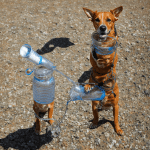The verdant charm of indoor plants can revitalize any space, injecting a breath of fresh air into your home or office. As indoor gardening enthusiasts, you understand that the secret to a thriving indoor garden revolves around how well you water your plants. But watering isn’t merely about pouring liquid into a pot; it’s a technique that requires understanding the needs of your plants and how moisture affects their growth. Let’s unlock the green thumb within you and delve into the best practices for watering your indoor plants efficiently.
Understanding the Importance of Water
Before we dive into the nitty-gritty of watering, let’s first understand why it’s so essential for plants. Water’s role in plant health is multifaceted. It aids in nutrient absorption, helps maintain plant structure, and serves as a catalyst for various chemical reactions in the plant.
A lire aussi : How to Create a Compact Vertical Bike Rack for Urban Dwellers?
In effect, water is the lifeblood of your plants. However, it’s not just about the amount of water you provide but also about how and when you do it. Overwatering and underwatering can both have dire consequences. So, let’s start with understanding the watering needs of different soil types.
Identifying the Soil Type
Not all soils are created equal, and thus, they don’t all require the same amount of water. It’s crucial to identify the type of soil your plant is growing in to determine the right watering schedule.
A découvrir également : How to Optimize Under-Bed Storage for Small Bedrooms?
For example, sandy soils drain quickly and require more frequent watering. Clay soils, on the other hand, retain water for longer periods and need to be watered less often. Soil amendments like peat moss or vermiculite can also alter the water-holding capacity of your soil mix.
It will be beneficial to know the type of soil your plant prefers before you even bring it home. A well-drained, loamy soil is typically the best choice for most houseplants.
Recognizing Your Plant’s Watering Needs
The next step in efficient watering is recognizing your plant’s individual needs. Various factors influence these needs such as the plant species, its size, and the conditions of its environment.
Certain plants, like succulents and cacti, are adapted to dry conditions and require less frequent watering. In contrast, tropical plants, like ferns and philodendrons, thrive in moist conditions.
Looking at the plant’s leaves can also provide useful hints. Plants with thicker, waxier leaves usually require less water than those with thin, delicate leaves. Moreover, larger plants will generally need more water than smaller ones due to their greater root mass.
Proper Watering Techniques
Now that you’ve established your plant’s water requirements, let’s move on to some practical watering techniques. Watering isn’t as simple as pouring water into a pot. Incorrect watering can lead to root rot, leaf drop, or even plant death. Here’s the golden rule: always water thoroughly but infrequently.
A good method is to water the plant until the water starts to drain out of the bottom of the pot. This means you’ve thoroughly saturated the root zone, which is where your plant absorbs water. After watering, allow the pot to drain completely before placing it back in its saucer to prevent water from sitting at the bottom, which could cause root rot.
Timing is Crucial
Finally, timing your watering correctly can be crucial to the health of your garden. Watering at the right time can help your plants absorb the moisture they need without becoming waterlogged.
Early morning is generally the best time to water your indoor plants. At this time, the temperatures are cooler, which allows the water to reach the roots without too much evaporation. If morning watering doesn’t work for you, late afternoon is a good secondary option.
Keep in mind that plants have different watering schedules. Some need water every few days, while others can go a week or two without watering. Always check the soil’s moisture levels before you water. If the top inch of the soil is dry, it’s usually a good sign that your plant is ready for a drink.
Watering your indoor plants might seem like a simple task, but it can be tricky to get it right. With these tips, you’ll be well on your way to becoming a skillful indoor gardener, ensuring that your array of green companions flourish in their pots. Always remember, effective watering is about understanding your plant’s needs and responding accordingly.
The Role of Soil Moisture and Type of Water in Plant Care
Understanding the soil moisture is a crucial part of plant care. The moisture content in the soil directly impacts how well the plants absorb water and nutrients. Too much water can cause a plant’s roots to become waterlogged and oxygen-starved. On the other hand, too little water, and the plant will become dehydrated and unable to carry out photosynthesis effectively
To check the soil’s moisture level, stick your finger about an inch into the soil. If it feels dry, it’s time to water the plant. If it feels damp, hold off on watering until it’s dry. However, remember that different plants have different watering needs. Some plants like the soil to dry out completely before watering, while others prefer consistently moist soil.
Another aspect to consider is the type of water you use. Tap water can sometimes contain levels of chlorine and other chemicals that are harmful to plants. If possible, use filtered or distilled water for your plants. If you are using tap water, let it sit out overnight to allow chlorine to evaporate before watering your plants.
The Effect of Container Types on Plants Watering
The type of container you use can also affect how you water your plants. Different materials will retain or lose moisture at various rates. For example, plastic pots retain moisture longer than terracotta pots, which are porous and allow water to evaporate more rapidly.
The size of the pot also plays a role in how often and how much you need to water your plants. Smaller pots dry out more quickly than larger ones, so plants in smaller containers will need to be watered more often.
Ensure the container has good drainage to prevent root rot. Plants can’t sit in waterlogged soil for long without developing problems. If your pot doesn’t have a drainage hole, consider adding one or use a layer of pebbles at the bottom of the pot to elevate the roots above any excess water.
Conclusion
Watering indoor plants effectively is a delicate balance of understanding the plant’s needs, the type of soil, the size and material of the container, and external factors like temperature and humidity. Overwatering and underwatering can both have detrimental effects, leading to problems like root rot or dehydration.
Remember, the golden rule of thumb for watering plants is to do it thoroughly but infrequently. Always check the soil moisture before watering and adjust your watering schedule based on the type of plant and environmental conditions. Using these best practices in plant care will help you maintain a thriving indoor garden. Keep in mind that becoming a good gardener takes time and patience, but the result is well worth the effort.











